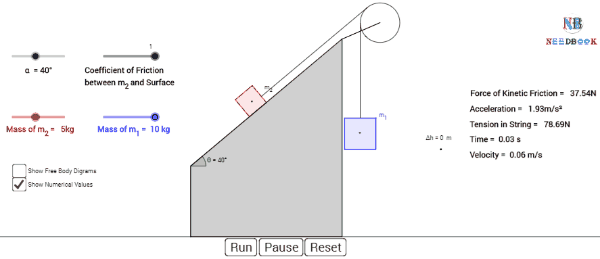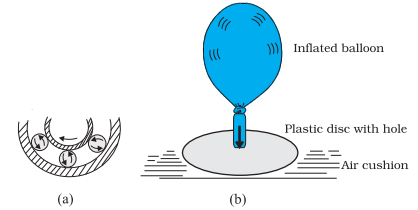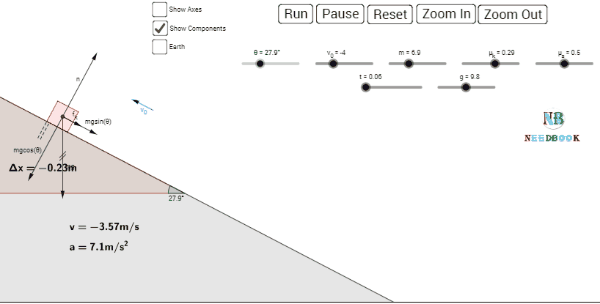Friction
• Let us consider the
example, a body of mass m at
rest on a horizontal table. The force of gravity (mg) is cancelled
by the normal reaction force (N) of the table. Now, assume a force F is applied horizontally to the body,
if the applied force is small it may not be enough to move the body. But, if
the applied force F is the only
external force on the body, it must move with acceleration ![]() , however small.
, however small.
• Clearly, the body
remains at rest because some other force comes into play in
the horizontal direction and opposes the applied force F, resulting in zero net force on the
body. This force ![]() parallel to the
surface of the body in contact with the table is known as
frictional force, or simply friction (below fig. (a)).
parallel to the
surface of the body in contact with the table is known as
frictional force, or simply friction (below fig. (a)).

Static and sliding friction:
(a)
Impending motion of the body is opposed by static friction. When
external force exceeds the maximum limit of static friction, the
body begins to move.
(b) Once the body is in motion, it is subject to sliding or kinetic friction which
opposes relative motion between the two surfaces in contact. Kinetic
friction is usually less than the maximum value of static friction.
• The subscript
stands for static friction to distinguish it from kinetic friction ![]() (above fig.
(b)). Note that static friction does not exist by itself. When there is no
applied force, there is no static friction. It comes into play the moment
there is an applied force. As the applied force F increases,
(above fig.
(b)). Note that static friction does not exist by itself. When there is no
applied force, there is no static friction. It comes into play the moment
there is an applied force. As the applied force F increases, ![]() also increases,
remaining equal and opposite to the applied force (up to a certain
limit), keeping the body at rest. Hence, it is called static
friction.
also increases,
remaining equal and opposite to the applied force (up to a certain
limit), keeping the body at rest. Hence, it is called static
friction.

• Static friction
opposes impending motion. The term impending motion means
motion that would take place (but does not actually take place) under the
applied force, if friction were absent.
• As the
applied force exceeds a certain limit, the body begins to move. It is
found experimentally that the limiting value of static friction ![]() is independent of the area of contact and
varies with the normal force(N)
approximately as :
is independent of the area of contact and
varies with the normal force(N)
approximately as :
![]() ------ (1)
------ (1)
where ![]() is a constant of
proportionality depending only on the nature of the surfaces
in contact. The constant
is a constant of
proportionality depending only on the nature of the surfaces
in contact. The constant ![]() is called the
coefficient of static friction. The law of static friction may thus
be written as
is called the
coefficient of static friction. The law of static friction may thus
be written as
![]() ------ (2)
------ (2)
• If the applied force
F exceeds ![]() the body begins
to slide on the surface. It is found experimentally that when relative
motion has started, the frictional force decreases from the static
maximum value
the body begins
to slide on the surface. It is found experimentally that when relative
motion has started, the frictional force decreases from the static
maximum value ![]() . Frictional
force that opposes relative motion between surfaces in contact is
called kinetic or sliding friction and is denoted by
. Frictional
force that opposes relative motion between surfaces in contact is
called kinetic or sliding friction and is denoted by ![]() . Kinetic
friction, like static friction, is found to be independent of the
area of contact. Further, it is nearly independent of the velocity.
It satisfies a law similar to that for static friction:
. Kinetic
friction, like static friction, is found to be independent of the
area of contact. Further, it is nearly independent of the velocity.
It satisfies a law similar to that for static friction:
![]() ------ (3)
------ (3)
where ![]() the coefficient
of kinetic friction, depends only on the surfaces in contact.
As mentioned above, experiments show that
the coefficient
of kinetic friction, depends only on the surfaces in contact.
As mentioned above, experiments show that ![]() is less than
is less than ![]() . When relative motion has begun, the acceleration of the body according
to the Second Law is
. When relative motion has begun, the acceleration of the body according
to the Second Law is ![]() . For a body moving with
constant velocity,
. For a body moving with
constant velocity, ![]() . If the applied
force on the body is removed, its acceleration is
. If the applied
force on the body is removed, its acceleration is ![]() and it eventually comes to a stop.
and it eventually comes to a stop.
• The laws of friction
given above do not have the status of fundamental laws like those
for gravitational, electric and magnetic forces. They are empirical
relations that are only approximately true. Yet they are very useful
in practical calculations in mechanics.
• Thus, when two
bodies are in contact, each experiences a contact force by the other.
Friction, by definition, is the component of the contact
force parallel to the surfaces in contact, which opposes impending or
actual relative motion between the two surfaces. Note that it is not
motion, but relative motion
that the frictional force opposes.

Rolling
friction:
• A body like a ring
or a sphere rolling without slipping over a horizontal plane will suffer
no friction, in principle. At every instant, there is just one point
of contact between the body and the plane and this point has no motion
relative to the plane. In this ideal situation, kinetic or static
friction is zero and the body should continue to roll with constant
velocity.
• In practice, this
will not happen and some resistance to motion (rolling friction) does
occur, i.e. to keep the body rolling, some applied force is needed.
For the same weight, rolling friction is much smaller (even by 2 or 3
orders of magnitude) than static or sliding friction. This is the
reason why discovery of the wheel has been a major milestone in human
history.
• Rolling friction
again has a complex origin, though somewhat different from that of
static and sliding friction. During rolling, the surfaces in contact
get momentarily deformed a little, and this results in a finite area (not
a point) of the body being in contact with the surface. The
net effect is that the component of the contact force parallel to the
surface opposes motion.
• We often regard
friction as something undesirable. In many situations, like in
a machine with different moving parts, friction does have a negative
role. It opposes relative motion and thereby dissipates power in the
form of heat, etc.
• Lubricants are a way
of reducing kinetic friction in a machine. Another way is to use ball
bearings between two moving parts of a machine (below fig. (a)). Since the rolling friction between ball bearings
and the surfaces in contact is very small, power dissipation
is reduced. A thin cushion of air maintained between solid surfaces in
relative motion is another effective way of reducing friction (below fig.
(b)).

Some
ways of reducing friction.
(a) Ball bearings placed between moving parts of a machine.
(b) Compressed cushion of air between surfaces in relative motion.
In many practical
situations, however, friction is critically needed. Kinetic friction
that dissipates power is nevertheless important for quickly stopping
relative motion. It is made use of by brakes in machines and automobiles.
Similarly, static
friction is important in daily life. We are able to walk because of
friction. It is impossible for a car to move on a very slippery road.
On an ordinary road, the friction between the tyres and the road provides
the necessary external force to accelerate the car.



